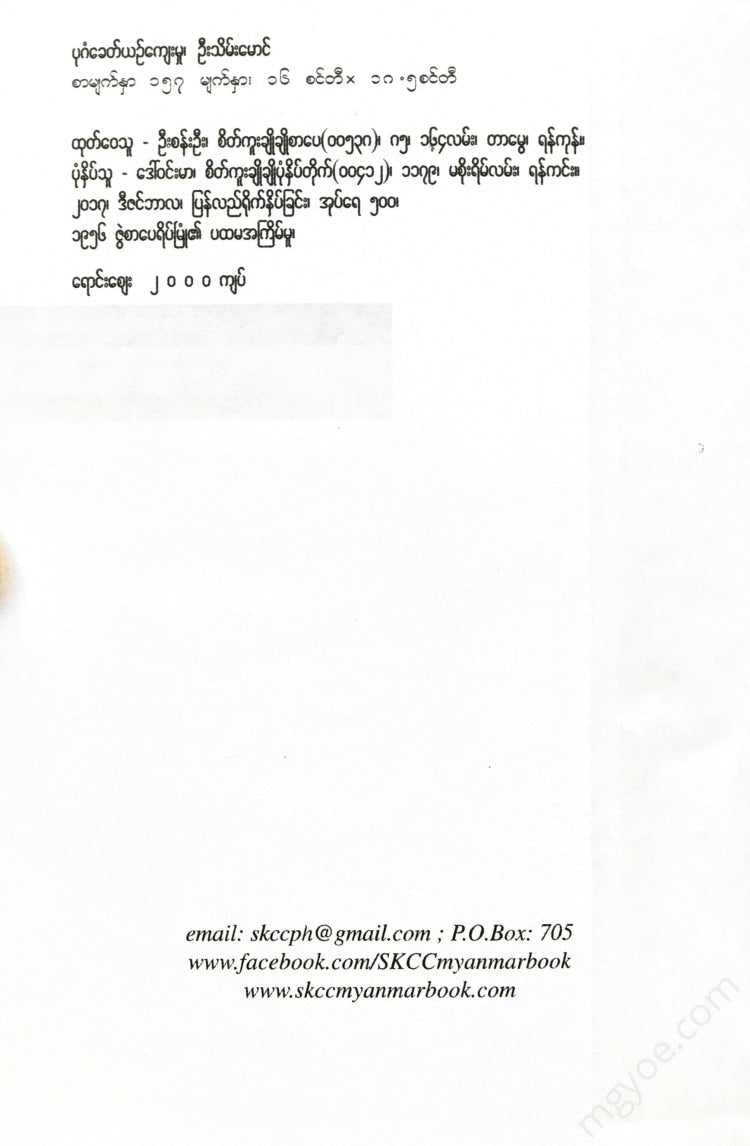စိတ်ကူးချိုချိုစာပေ
U Thein Maung - Bagan Period Culture
U Thein Maung - Bagan Period Culture
Couldn't load pickup availability
Bagan era culture
How the Burmese people came into being
"Myanmar is from Tagaung" is a traditional saying among us Burmese people. However, it seems that the men who were there when the first Tagaung kingdom and the second Tagaung kingdom were established were not Burmese, and it is necessary to know this before reading this book on the culture of the Bagan period.
The first Tagaung Kingdom was founded by Indians who came from India to live in a land far away from their enemies, where there was water and grass. The second Tagaung Kingdom was founded with the same purpose as the first Tagaung Kingdom. The people who established and ruled the new kingdom were Indians from outside Burma, and the people who were governed were not Burmese, but the original Burmese people.
The original ethnic groups that lived in Burma before or around the time of the founding of the Tagaung Kingdom are not the same as the ethnic groups that are now called "Burmese (or) Unionists" in the Union era.
Modern historians from both the East and the West believe that the original ethnic groups of Burma were related to the indigenous people of the Andaman Islands, which are called Amman Island in English, and thus were closely related to the Andaman Islanders.
The great rivers such as the Ayeyarwady, the Salween, and the Chindwin, flowing from north to south, seem to be inviting people looking for fresh water and green pastures to come and live in Burma. Therefore, it is possible to say that many ethnic minorities from China, Tibet, and India have gradually entered the river basins of these great rivers, which have favorable climate and soil fertility.
It is well known that Burma, which is very sparsely populated, is sandwiched between the vastly more populous countries of China and India. Therefore, if we consider that the Burmese culture has grown under the influence of the cultures of those who came from China and India, and then, after a long period of isolation, a separate Burmese culture has developed, it is not right and we do not expect that there will be many objections.
According to the theory of ethnic historians, Tibetan, Burmese, Mon, and Khmer ethnic groups gradually entered the country, and the original indigenous peoples were not able to compete and gradually moved south. After hundreds of thousands of years, the indigenous peoples were said to have moved to remote areas in the south of Burma, far away from the seas and lands.
The Tibeto-Burman and Mon-Khmer ethnic groups that entered Burma are believed to be descended from the Maungdaw ethnic group. Thai ethnic groups have also entered. The traditional names of the Tibeto-Burman ethnic groups are Pyu-Kamran and Thet. Ethnic historians believe that the Thet became the Chin people, while the Pyu people disappeared into the Burmese people. According to the information contained in ancient Burmese literature, it is clear that the Burmese were called Pyu. Some Thai ethnic groups still live in Shan State.
The Pyu people disappeared from Sri Kshetra and not long ago, but after the establishment of the new kingdom, Bagan, they gradually developed and flourished. This new separate nation became the Burmese people. Therefore, we prefer to use the new motto "Myanmar is from Bagan" instead of the motto "Myanmar is from Tagaung".
Mr. Harvey, the Burmese historian, says that the Burmese are a race of Mongkuts. But their traditions are not related to China or Tibet, but to India. In the early history of the Burmese, we read that they are descended from the lineage of the Buddha. Even the legends are mostly Hindu legends, as he writes in his Burmese History.
We read the following in a book titled Burma and India by Professor Desai, who used to serve as a history professor at Yangon University.
“The Burmese are neither Indian nor Chinese. They are a people who have developed and emerged as a separate people over a period of more than a thousand years. During that period, they have developed their own political system and social relations with their own intelligence. Although they have taken refuge in the cultural shadow of China, India, and especially India, they have their own language.









